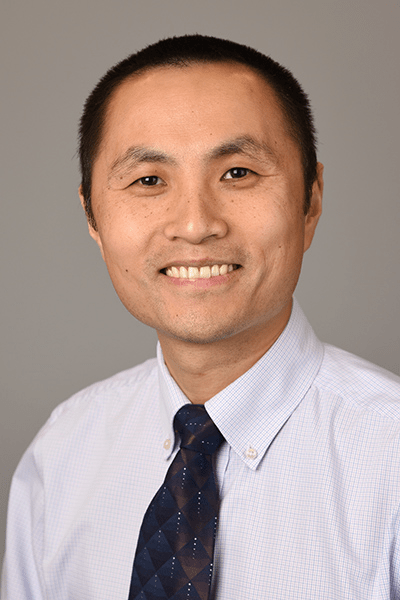
Weiming Mao, MD, PhD
Jay C. and Lucile L. Kahn Professor of Glaucoma Research and Education
Professor of Ophthlamology
Professor of Biochemistry, Molecular Biology & Pharmacology
- Address
-
GK 305V
OPTH
Indianapolis, IN 46202
Bio
Dr. Mao received his Bachelor Degree of Medicine at Fudan University and was an Ophthalmology Resident at Shanghai First People’s Hospital in China. He joined the Vision Science Graduate Program at University of Alabama at Birmingham as a PhD student, and was mentored by Dr. Shu-Zhen Wang in retinal development research. After obtaining his PhD degree, Dr. Mao received his postdoctoral training in glaucoma research by Dr. Abbot Clark at University of North Texas Health Science Center. He became an Assistant Professor in 2013 at UNTHSC. He was also the Graduate Advisor of Visual Science Graduate Program and Associate Director of Research at UNTHSC. Dr. Mao joined faculty of Department of Ophthalmology at IUSM in July, 2018.
Key Publications
| Year | Degree | Institution |
|---|---|---|
| 2008 | PhD | University of Alabama at Birmingham |
| 2001 | MB,BS | Fudan University |
My research focuses on glaucoma, a leading cause of blindness worldwide. In the visual system, retinal ganglion cells play a key role in transmitting visual signals from the eye to the brain. In glaucoma patients, damages to the retinal ganglion cell (RGC) soma and axon lead to progressive loss of visual function and eventually blindness. Although glaucoma has been studied for decades, the exact disease mechanism(s) is still not fully understood.
Many clinical studies have shown that elevated intraocular pressure (IOP) is the most important risk factor and causative factor of glaucoma. All current FDA approved anti-glaucoma medicines protect visual function by lowering IOP to a safe level. However, these anti-glaucoma medicines tend to lose efficacy during prolonged use.
Glaucomatous ocular hypertension (OHT) is due to pathological changes in the trabecular meshwork (TM) which lead to elevated aqueous humor (AH) outflow resistance. Although current ocular hypotensive medicines lower IOP, they work mainly through either inhibiting AH production or enhancing uveoscleral outflow. None of them treat the pathological changes in the TM. Since the TM outflow pathway is responsible for majority of the AH outflow, with the progression of TM damage, the expansion of the uveoscleral outflow pathway will eventually be unable to compensate for the loss of TM outflow. We believe it is the reason that current ocular hypotensive medicines lose efficacy in the long run.
Current research projects
1.Determine the cross-talk between the Wnt and TGFβ signaling pathways in the TM.
We have shown that both pathways are glaucoma-associated and dysregulation of either pathway leads to IOP elevation. This project aims to determine how the two pathways interact with each other in glaucoma pathogenesis, as well as the key proteins that connect the two pathways in the TM. We have shown that the two pathways cross-inhibit each other’s activity at transcriptional level possibly via the formation of a smad4-β-catenin nuclear complex. We will further determine the molecular mechanism of this protein complex and its impact on TM homeostasis as well as IOP in human and mouse eyes. We believe that manipulating the two glaucoma-associated pathways simultaneously would be an efficient way to control IOP and glaucoma.
2.Determine if CRISPR interference is a useful tool for manipulating gene expression in the trabecular meshwork.
The CRISPR interference technology uses a mutant Cas9 (dCas9) fused with a DNA or histone modification enzyme. With the help of sgRNA, the dCas9-KRAB (KRAB is an enzyme that deacetylates histones) complex will find a specific gene promoter region, alter histones, and shut down/off the expression of that gene. This approach is superior to RNA interference because it will not overload the cells with excessive transcriptional tasks (e.g. to express large amounts of shRNA). We have constructed 24 expression vectors to test the efficiency of different targeting regions, and the results are very encouraging. We will further select the best ones for experiments in human donor eyes as well as mouse eyes. We hope this technology will help us to turn down excessively expressed glaucoma-causative factors (e.g. TGFβ2) and help to correct the pathology in the TM and lower IOP.
3.In collaboration with Dr. Vijay Raghunathan at University of Houston to determine the contribution of actin microfilament rearrangement to TM cell stiffness as well as whether a set of actin-binding proteins are able to promote this rearrangement.
In the glaucomatous TM, actin microfilament rearrangement leads to the formation of cross-linked actin networks (CLANs). However, whether CLANs cause high stiffness in glaucomatous TM cells and what proteins promote CLAN formation are still unknown. Our preliminary data have shown that CLAN positive TM cells have high stiffness using atomic force microscopy. We also found 5 actin-binding proteins that are enriched in CLAN forming TM cells using cytoskeletal protein enrichment and 2D-DIGE. Our future studies will focus on whether CLANs induced by different glaucomatous insults are similar and whether the 5 actin-binding proteins are sufficient and necessary for CLAN formation.
Desc: Trustees' Teaching Award
Scope: University
Date: 2024-04-01